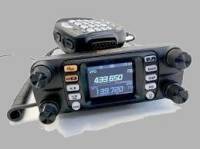|
Click The Radio Image On The Left To Return To Homepage Feel Free To Copy Any Information On The Webpages |
| |
|
Press F5 To Refresh Pages
146.920 Output / 146.320 Input PL123.0 449.600 Input / 444.600 Output PL100.0 Repeater Coverage
Below is repeater RF coverage plot for the Tombstone, AZ UHF & VHF repeaters. The RF coverage plot is for the current repeater installation site based on a 20 watt repeaters at a antenna height of 42 feet. Unless you're part of linked repeater network, your repeater has limitations, however, the Tombstone 440 repeater is now part of a linked repeater system with umlimited coverage potential, please read the IMRS Repeaters Page on this website.
The RF 2 meter repeater coverage plot is for 42 feet, centered on my Tombstone, AZ repeater site location. The RF coverage plot shows that power isn't always the solution, elevation and tower height help to overcome some line of sight issues, but not always. Building obstructions and shadows caused by ridges, hills, and mountains all contribute to the ability of a repeater, mobile or base, to communicate with repeaters. The gain and location of a mobile antenna, the power output of a transceiver, and the sensitivity of a station, mobile or base, all contribute to the overall performance of a mobile or repeater base station.
Although Tombstone resides at an elevation of approximately 4600 feet, it also sits in a sort of a bowl or mesa and is surrounded by mountains or hills (the same thing), back home they would call them mountains, out here they call them hills. The point is, that RF signals don't go through mountains, they just stop short there and are blocked and bounce around.
Please keep this in mind, the Tombstone repeater at this moment is functioning as a "local area repeater", not a wide area coverage repeater, more details follow below.
The repeater incorporates both 110 volt AC and 12V DC power supplies for emergency purposes, it's all backed up by a generator that power our home, if the need arises it will keep the repeater online during emergencies..
Some of the factors used in plotting RF coverage are:
1. Location 2. Antenna Height Above Ground 3. Frequency 4. Output Power 5. Antenna Gain (Dbi) 6. Polarization 7. Surface Refractivity (N-Units) 8. Direlectric Constant Of Ground 9. Conductivity Of Ground 10. Climate Zone
The "blue" shaded variations in the RF plots indicate the dbuV/m (Decibels Relative To One MicroVolt / Field Strength). Field strength ranges from 100 (darkest shade of blue) to 45 (lightest shade of blue).
The most important part of the RF plots has to due with the areas south, southwest and east of Tombstone. The "Tombstone Hills" to the southwest, the mountains south to Herford, AZ and Bisbee, AZ, and coverage overall to the the east is affected considerably. This has always been a troublesome area for RF communications. The mountainous topography in Arizona presents problems for RF communications, shadows and line of sight obstacles are a common occurrence and difficult to manage unless you have a mountain top site at a very high elevation with a tower of sufficient height. Even then, line of sight in certain directions, can still present communications difficulties from the tower to mobiles, or to portables (hand helds). Once one passes though the Tombstone Hills, and gets father down range the signals improve considerabley due to an improved line of sight, as you enter into Sierra Vista the signal will be near full quieting in some areas, I know, I've run this test as I visit Sierra Vista weekly.
KD5DOG (Ron) and myself ran signal tests using FM voice audio while maintaining communications to and from the Tombstone VHF & UHF repeaters and Sierra Vista, AZ while using his HT and 5 watts. Further testing, while using mobile rigs and 10 - 20 watts, we have been able to maintain full quieting communication to and from the Tombstone, AZ repeater all the way along highway 90 between Sierra Vista, AZ and Interstate 10 at Benson reliably. In some directions range is 30 - 40 miles, in others it limited to 8 - 10 miles. If we're successful with establishing LAN Links range would change dramatically. The new Yaesu DR-2X Fusion repeaters now allow LAN linking of up to 100 repeaters, if we can develope relationships with other DR-2X LAN link repeaters owners and clubs wide area coverage will become a reality. It's all up to DR-2X repeater owners with LAN boards installed to take advantage of this tremendous feature of the DR-2X repeater. LAN linking is direct, it's not dependant on a Japanese server like WIRES-X and eliminates lag time in the connection.
Current GPS Location: 31. 43. 44 North -110. 02. 48 West 30 Watts @ 42 Feet Antenna Height @ 8.6 Dbi Gain
The AB7CQ & W9RIC Repeaters Are IMRS LAN Linked Between Arizona & Wisconsin. First Lan Linked Repeaters In North America.
Bob Krueger, AB7CQ Web Administrator 146.920/146.320 PL 123.0 444.600 / 449.600 PL 100 Repeater IRLP Node: 7515 PL 114.8 ab7cqradio@ebidpal.com |
